
In Conversation: Rathnavelu ISC!
Nov 09 2024
Rathnavelu ISC, one of India’s most influential cinematographers, has consistently pioneered new visual techniques and technologies in the industry. With each project, he has pushed creative and technical boundaries, setting new standards for Indian cinema. His work on Nandha redefined the cinemascope format, while Rangasthalam delivered a grand, rustic aesthetic that captivated audiences. In Vaaranam Aayiram had many periods,geographical variations and Enthiran, he developed innovative lighting diagrams and comprehensive plans for over 2000 CGI shots, showcasing his meticulous approach to visual storytelling.
Devara Part 1 which was highly praised for its visual spectacle,great box office run and currently streaming at Netflix

Rathnavelu shares his visual Journey with SICA.
When you first encountered the story of Devara, what were your initial thoughts about bringing it to life visually?
From the start, I knew Devara needed an immersive world that would feel both epic and grounded. Real locations like Vizag couldn’t create the atmosphere we wanted. While I initially considered existing beach sets, they didn’t suit the scope of the film. After hearing the story, I decided to create our own never seen visual world inside a set, i convinced producers to go for a huge set as the film has three major mid-sea adventures involving fog, ships, huge tides underwater, over water, and burning boats.
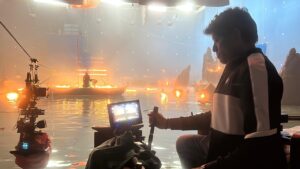
How did you decide on a location for filming the ocean scenes?
We scouted globally. In London, we saw a dust-free, 20-foot-deep pool, and in Belgium, there was space for a huge ship, but the logistics didn’t work for us. I convinced the producer to build a massive set at Tahir Studio, combining two floors into one to create a 200×160-foot area with a 5-foot depth. This allowed us to create pyro effects, boat action, bomb blasts, and hurricanes in a controlled environment, giving us the flexibility to shoot day-for-night.
You mentioned the moon as a metaphor. Could you explain its role in the visual storytelling?
The moon reflects Devara’s journey and emotional shifts, with each phase symbolizing key points in the story. I wanted it to feel like a character, so I kept changing the moon phases as scenes progressed—from full moon to cloudy to half-moon. For instance, during the interval, we use a half-moon to represent a pivotal moment. I also adjusted the moonlight to evoke beauty, mystery, and moodiness throughout.
I visualised a broader Moon as subject opposed to usual point source Moon present in other films,
Bigger moon created a atmospheric feel and also subjective experience.
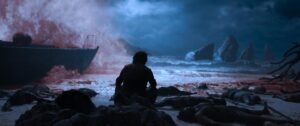
What was your main approach to lighting these scenes?
I wanted a low, soft key light with minimal fill to keep it directional yet natural. For the interval block, I used extreme low-lighting, shooting at T 0.5 with ISO 1600, to create a mysterious, immersive mood. For underwater lighting, challenge was to create caustic effect, Refractions and dispersions the way i had imagined during preproduction stage, for that i have to go for multiple methods and combine different sources together and use technology wisely.
But most important thing i achieved through lighting was to handle water elements most believable and also a visual spectacle,it was always a challenge to achieve it when you have CGI.
Hollywood VFX supervisors often praised me during filming the lighting i had developed for the water scenes, which was a gratifying validation.
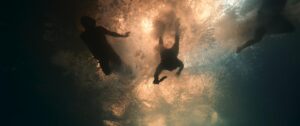
Could you talk about the visual effects coordination, especially for the underwater scenes?
Coordinating with the VFX team was essential. I created on-set lighting strikes and fog, and from a VFX point of view, we managed water extensions, sky, and cloud consistency to make the water look authentic. I provided night sky and moon references for consistency. VFX supervisor Yugendhar helped extensively, and we entrusted Digital Domain, Phantom FX, and other leading companies for seamless integration.
You mentioned adding unique underwater set pieces. How did that contribute to the visuals?
I wanted a distinct underwater feel, so we used a “forgotten island” look with distant mountains, unlike the usual black backdrop. The underwater set was enhanced with rugged, rocky features inspired by the Rockies.
Maintaining water quality on set must have been difficult. How did you handle color consistency?
Water came from various wells to fill our tank, and we carefully monitored artists’ costumes to keep them detergent-free. Stunts went on for weeks, and though the water was filtered periodically, its color still changed, shifting from light blue to green and even greenish-yellow when sunlight hit it. We kept the water as dust-free as possible, but we also had to address these color shifts in post-production.
Could you share a bit about the shark sequence and how you prepared for it?
This sequence was both technical and creative.
For this, I employed dry-for-wet technology, one of the first in India to do so, and we created a rig with a shark dummy and Junior NTR mid-air, adding wind and lighting effects.
To further push boundaries, I asked the production designer to create a 12×12 aquarium filled with water, mounting lights over it to create a caustic effect when light passed through.
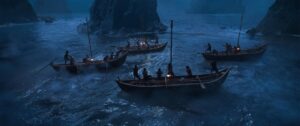
Filming underwater must have been challenging. How did you manage it with the stunt team
We provided special training for our stunt artists, collaborating with scuba divers to ensure they could hold their breath effectively while performing underwater at 20 feet. Safety and timing were key for achieving these sequences seamlessly.
Can you tell us about the equipment and techniques you used for capturing the action?
For the action scenes, I used a 150-foot-long cable cam rig attached to gimbals, GFM dollies, Trinity rigs, Steadicam, and Easyrigs. This setup allowed for dynamic and immersive shots, capturing the rugged, expansive scenery authentically.
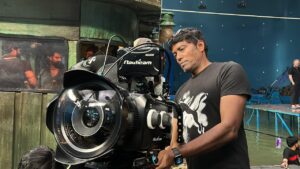
What cameras and lenses did you rely on for Devara?
I primarily used the Arri LF for its softer color rendering and the Red Raptor X for high-speed shots at 240fps, which gave us excellent latitude. Arri Signature Primes, paired with Arri Impression filters, provided unique effects. I used the filter’s negative side, creating an inward-curved bokeh with a rustic look, especially effective in a opening song against a Ayudha pooja festival backdrop.
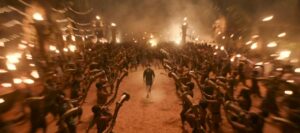
Did you have a specific color palette in mind?
I chose a bluish-grey tone with subtle pops of color to keep the visuals interesting but cohesive. For underwater shots, we combined darker hues with subtle highlights for an otherworldly effect. We also balanced water color variations that changed frequently during shooting to achieve a consistent look in post.
Tell us about the lighting for the underwater battle sequences scenes.
For lighting underwater, I rigged 100 Vortex lights to simulate firelight effects of Boats burning, Additionally, the Arri M90s provided a hard light source piercing through the water, adding layers to these scenes’ visual richness.
As said earlier i wanted caustic look, water dispersion, refractive values all to be in a precise manner for that i had many approaches shifting each time like building aquarium filled water passing light through it, connecting lights to DMX controllers varying levels in a programed manner.

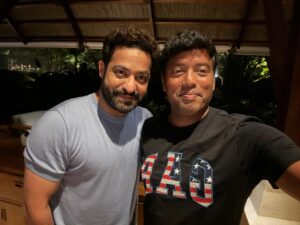
How did the cast react to such an immersive environment?
One unforgettable moment was when Junior NTR complimented the lighting during the interval sequence. Even with a green screen backdrop, the lighting alone conveyed the scene’s pathos, which felt like a real achievement as a cinematographer—when lighting itself can evoke such powerful emotion.
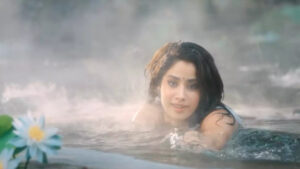
You also shot a sensuous song with Janhvi Kapoor. What approach did you take for that?
We shot at Craby Islands, contrasting Janhvi’s glamour with nature’s raw beauty. I framed her with water streams and darker foliage, using outdoor dry ice to create a dreamlike effect. This made her presence stand out beautifully against the rugged landscape.
Who was your colorist, and how did their work support the film’s tone?
My colorist was Mr. David from the Czech Republic. His expertise in handling VFX footage was invaluable, especially with over 2,500 VFX shots. Working with Annapurna DI Suite, we used Baselight, occasionally running two grading systems simultaneously to ensure color consistency across complex scenes.
Looking back, what made this project memorable for you?
Devara was a landmark experience—a collaboration that allowed me to push boundaries creatively and technically. I’m grateful to Director Koratala Siva, the producers, and Junior NTR for trusting my instincts. It’s an experience I’ll carry forward in my journey as a visual artist.
Interview part two continued on Rathnavelu earlier film Journey and Technical achievements……
Article by
CJ Rajkumar
Author/ Cinematographer
